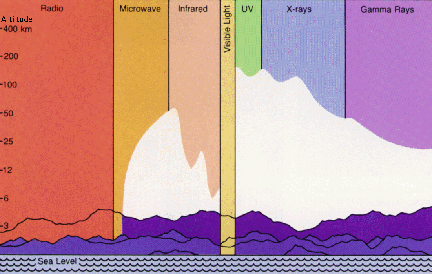nick c wrote:hello BlueCrab,
Why does space appear black?
As opposed to being filled with the glow of endless stars and galaxies?
Are you refering to [url2=
http://en.wikipedia.org/wiki/Olbers'_paradox]Olbers Paradox[/url2]?
If the universe is assumed to contain an infinite number of uniformly distributed luminous stars, then:
1. The collective brightness received from a set of stars at a given distance is independent of that distance;
2. Every line of sight should terminate eventually on the surface of a star;
3. Every point in the sky should be as bright as the surface of a star.
Don Scott has written on this subject, explaining it as simply a result of the limitations of the human eye, which cannot perceive light beyond a certain magnitude.
It may also help to remember that the human eye is different from
photographic film or a CCD chip. It does not integrate over time. The
longer we expose a photographic plate to starlight the brighter the image
becomes. (There is a limit even to this process in film due to what is
called reciprocity failure.) But, humans can stare at the night sky all
night long and not see anything they didn't see after the first few minutes.
Things don't get brighter for us the longer we look at them. So
theoretically the longer we expose our CCD camera chip, the brighter the
image (deeper into space we can see). This is not true for the human eye.
We can see the 8400 or so stars that we can see, and all the zillions of
others might as well not be there AT ALL as far as our humble naked human
eyes are concerned.
Olber's Paradox is not a paradox at all if you look at it correctly. It is
yet another example of theoretical mathematics applied incorrectly to a real
world phenomenon. Or a mathematician might say, "They got the upper limit
on the integral wrong."
Don Scott
http://www.kronia.com/thoth/ThVIII02.txt
Nick
Wow, you mean I might be able to add something to this (assuming it hasn't already been brought up)? Cool! At least 3 other considerations:
1) The human eye cannot see the entire spectrum.
2) The Earth's atmosphere screen out some portions of the spectrum, so even if we could see it, we wouldn't necessarily unless we were outside the atmosphere, but then we'd be dead.
3) Intensity laws for appx point sources.
Part 1: The human eye sees only a very small portion of the EM spectrum. Any part we can't perceive, appears black. Black is null, black is the "lack" of light [that we can perceive].
It's interesting to watch movies recorded with a FLIR / infrared camera. It picks up a different portion of the spectrum than what we are able to see and converts it into "false colors" colors (in the "visible" part of the spectrum) we can comprehend.
I'm sure that devices can probably be made to do the same for x-rays, microwaves, etc. Would be interesting to take video of various things like lightning or tornadoes in different wavelengths and then overlay them to see what all we're missing with our limited eyesight.
Part 2: The ionosphere absorbs, filters, or reflects out some portions of the EM spectrum. So, even if we could see those portions, the photons might not ever reach us to be seen! That's one reason we like putting satellites into orbit. They get outside most of the atmosphere and are able to more clearly see things that are obscured or invisible from inside the atmosphere, in addition to being able to see parts of the spectrum not visible in "visible" light.
Part 3: What was part 3? *Scrolls up*
Ohh, right,
intensity laws...
Might want to look up
Irradiance or
Luminous intensity...
From the Irradiance article:
If a point source radiates light uniformly in all directions and there is no absorption, then the irradiance drops off in proportion to the distance from the object squared, since the total power is constant and it is spread over an area that increases with the square of the distance from the source.
In other words. stars are a long, long, long way away. So, whatever emissions they make per second or per hour generally spread out over vast distances. They may spread out such that they drop below the threshold at which we can perceive them. Though, if on were to assume that thee are stars in every direction then one might ask why there isn't a "fog" of light as various waves from different point sources overlap or intersect. But, Don Scott's answer seems to answer that. There *IS* a fog out there, but it's below our perception threshold, or outside our "visible" part of the spectrum. However, cameras can accumulate light from the "fog" or point sources below our perception threshold. That's why satellites and radio telescopes may use long exposures to ferret out more and more faint signals.
And that's not even getting into the issue of light being blocked by intervening dust, absorbed by the interstellar medium, or being absorbed in the visible part of the spectrum and re-emitted in non-visible parts of the spectrum (IR, UV, x-ray, microwave, radio wave, etc.).
Cheers,
~Michael Gmirkin
